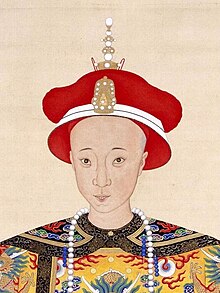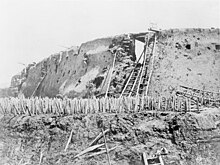1875 in China
This article needs additional citations for verification. (September 2018) |
| |||||
| Decades: | |||||
|---|---|---|---|---|---|
| See also: | Other events of 1875 History of China • Timeline • Years | ||||
Events from the year 1875 in China.
In 1875,[1][2] China was undergoing a period of significant changes, both internally and externally. The Qing dynasty, which had been ruling China for centuries, was facing mounting challenges from Western powers seeking to establish trade relations and exert influence over the country. Additionally, China was grappling with internal rebellions and efforts to modernize the nation. This article explores some of the key historical moments in China during the year 1875.
Tongzhi Restoration
[edit]
The Tongzhi Restoration[1] was a significant period in Chinese history that occurred during the reign of Emperor Tongzhi of the Qing dynasty from 1861 to 1875. As Emperor Tongzhi ascended the throne at a young age, Empress Dowager Cixi and Prince Gong held considerable power as his regents.
During the Tongzhi Restoration, China recognized the urgent need for modernization in response to internal and external challenges. The restoration aimed to modernize the military, promote economic development, and implement educational reforms. The government endeavored to adopt Western technologies, knowledge, and systems to strengthen the nation's military and administration.
As part of the restoration, modern schools were established to introduce new subjects and ideas into the Chinese education system. Moreover, efforts were made to foster industrialization and economic growth to compete with Western powers in trade and commerce. The Tongzhi Restoration represented a significant step toward acknowledging the importance of modernization and set the groundwork for further reform movements in China.
Modernization Efforts
[edit]In 1875, China was undergoing a significant period of change, with efforts to modernize the nation in response to internal and external challenges. The Qing dynasty recognized the urgent need to strengthen China's position, facing rebellions and pressures from Western powers. Various sectors of Chinese society were targeted for transformation through modernization efforts.
Educational reforms[1] aimed to overhaul the traditional examination system, introducing new subjects like science, mathematics, and foreign languages in modern schools to produce a more educated generation. Industrialization was seen as vital to compete with advanced Western industries, leading to the establishment of modern factories, infrastructure development, and technological advancements.
Military modernization involved adopting Western tactics, weaponry, and training methods to enhance the military's effectiveness. The opening of treaty ports encouraged foreign trade and investment, facilitating economic interactions with Western powers. Additionally, the expansion of the telegraph network and introduction of railways improved communication and transportation across the country.
However, conservative resistance, Empress Dowager Cixi's influence, and financial constraints hindered the full realization of modernization goals. Despite these challenges, the modernization efforts of 1875 laid the foundation for subsequent reform movements in China, propelling the country on a path of political, economic, and social transformation in the years to come.
Second Opium War - Aftermath
[edit]
the Second Opium War[1] from 1856 to 1860, China experienced far-reaching consequences that continued to affect the nation in 1875. The war resulted in a humiliating defeat for China against Britain and France, leading to additional foreign encroachments and concessions.
The Treaty of Tientsin, imposed on China in 1858, further eroded sovereignty by opening more ports to foreign trade and granting extraterritorial rights to Western nationals. Heavy reparations and indemnities imposed on China strained the already fragile economy.
Territorial losses required China to cede land to Britain and France, weakening central authority and contributing to regional instability.
Foreign influence expanded significantly with the establishment of exclusive concession areas in Chinese cities, where Western powers operated under their laws. This fueled anti-Western sentiments among the Chinese population.
The aftermath of the Second Opium War also fueled internal unrest, exemplified by uprisings like the Taiping Rebellion and the Nian Rebellion, partly driven by discontent with the Qing government's perceived weakness in handling foreign powers.
In conclusion, the Second Opium War's aftermath in 1875 left a profound impact on China, exposing vulnerabilities and contributing to the decline of the Qing dynasty. The war's legacy set the stage for ongoing challenges as China navigated a changing global landscape.
Muslim Rebellion in Yunnan
[edit]The Panthay Rebellion, led by Du Wenxiu, was a Muslim rebellion in Yunnan province. It stemmed from ethnic and religious tensions between the Hui Muslims and the Han Chinese. The rebellion, which began in 1856, had been ongoing and posed a significant challenge to Qing rule in the region.
Nian Rebellion - Aftermath
[edit]
In 1875, the aftermath of the Nian Rebellion[1] continued to cast its shadow over China. The rebellion, which occurred from 1851 to 1868, left a trail of destruction and economic upheaval in the affected regions.
To address the grievances that fueled the rebellion, the Qing government introduced some land and tax reforms. However, these measures were limited in their effectiveness and failed to fully resolve the underlying issues that had sparked the uprising.
The Nian Rebellion aftermath underscored the necessity for military modernization and administrative reforms to bolster the governance of the Qing dynasty and ensure stability.
The impact of the rebellion on China's economy, society, and political stability highlighted the challenges faced by the Qing government in addressing internal unrest and the discontent among the populace. The events of the Nian Rebellion and its aftermath were part of a broader context of internal challenges and uprisings that marked the landscape of 19th-century China.
Trade and Treaty Ports
[edit]Foreign trade continued to grow in China during this period, especially in treaty ports established under previous agreements with Western powers. These treaty ports allowed foreign merchants to trade with China under specific regulations and contributed to increased economic interactions between China and the West.
Anti-Christian Persecution
[edit]There were instances of anti-Christian sentiment and persecution in some regions of China, particularly in the interior. Christianity had been spreading in China, and some local officials and communities viewed it as a foreign influence threatening traditional Chinese values.
Piracy in the South China Sea
[edit]The southern coastal regions of China were plagued by piracy during this time. Piracy not only affected maritime trade but also posed security challenges for coastal communities. The Chinese government struggled to contain these pirate activities.
It is essential to understand that the events mentioned above were part of a larger historical context that shaped China's trajectory in the late 19th century. China faced both internal and external pressures, and the country's responses to these challenges would have far-reaching consequences for its future.
During this period, the Qing dynasty faced numerous internal rebellions and external threats that would ultimately contribute to its decline. The modernization efforts initiated during the Tongzhi Restoration would continue in the following years, but China's efforts to modernize and catch up with the Western powers were often met with resistance and limitations.
Furthermore, China's relationships with Western powers and other countries were significantly impacted by the unequal treaties and reparations resulting from the Opium Wars. These events underscored the need for China to reassess its international relations and strengthen its domestic capabilities to maintain its sovereignty and independence.
The year 1875 was a critical juncture in China's history, marked by attempts at modernization, internal conflicts, and the legacy of foreign interventions.[1] These historical moments would shape China's path in the following decades and lay the groundwork for significant political, social, and economic transformations in the early 20th century.
Incumbents
[edit]- Tongzhi Emperor (15th year)
- Regent: Empress Dowager Cixi
- Guangxu Emperor (1st year)
Events
[edit]- Tongzhi Emperor dies without an heir, Empress Dowager Cixi selects her three-year-old nephew Zaitian as the Guangxu Emperor to succeed him
- Dungan Revolt (1862–77)
- February 21 — Margary Affair British explorer Augustus Raymond Margary and his entire staff murdered in Yunnan
- 60 to 70 Christian women in Amoy attended a meeting presided by a missionary John MacGowan formed the Heavenly Foot Society (tianzu literally meaning Heavenly Foot),[3][4] opposing the practice of footbinding
- American trading company Augustine Heard & Co. becomes bankrupt
Births
[edit]Deaths
[edit]- Empress Xiaozheyi
- Ding Yan
- 12 January — Tongzhi Emperor
References
[edit]- ^ a b c d e f ""China In 1875: Modernization, Rebellions, And Foreign Influences" » MyFirstKnow.com". myfirstknow.com. 2023-07-22. Retrieved 2023-07-22.
- ^ "MyFirstKnow.com »". myfirstknow.com. Retrieved 2023-07-22.
- ^ Dorothy Ko (2008). Cinderella's Sisters: A Revisionist History of Footbinding. University of California Press. pp. 14–16. ISBN 978-0520253902.
- ^ 不缠足会[permanent dead link]


 French
French Deutsch
Deutsch